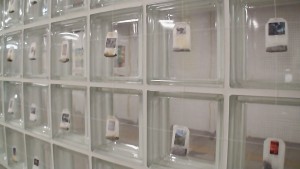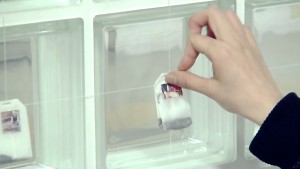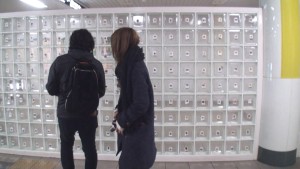駅ナカアート2015作品紹介Vol.1 /「マドレーヌのかけら」太秦天神川駅
Junichi Umezu
Sakurako Imai
Shiori Kaida
Elsa Marc
Clédia Fourniau
“La petite madeleine”
「マドレーヌのかけら」
1500 mm x 2000 mm
Branch, acrylic, paper, metallic shutters, salt, tea, fragrances
Three sensations of smell, three visual impressions, three small mental landscapes, fixed, frozen and vertically crystallized. Layed flat and delimitated by metallic shutters, the perfume of the rain, of the first snow and of the asphalt are merging, it takes an appearance in the space and vanishes. For the senses, this is like a duel between lightness and heaviness, between the full and the empty, between the acid and the diluted.
枝、アクリル塗料、紙、金属の格子枠、塩、紅茶、香り
(固定され、凍りつき、垂直に結晶した、各々3通りの嗅覚、視覚、そして小さな心象風景。金属の格子枠によって区切られて、雨と初雪とアスファルトの香りがこの場に現れては消えてゆく。私たちの感覚にとって、これは軽さと重さの、充溢と空虚の、鋭さと希薄さの間の闘争のようだ。)
It is important to note the essential role of smell in the constitution of memory and sensitivity, identity and otherness. It’s one of the best way to connect with memory and conscious mind.
It reminds us the famous French book “In Search of lost time” from the writer Marcel Proust and especially the cookie’s passage which tells that the smell and the taste are an impressive reminder of the past. The writer explains that when he was a child, his aunt was giving to him cookies that he used to dip into his cup of tea. Grown up, he realizes that to eat again the same cookie in the exactly same way is giving a new life to his childhood. Through all these pictures, the project “la petite madeleine” suggests the Kyoto’s subway people the experimentation of a dive into their own past.
嗅覚は、私たちの中で記憶と感受性、そして自己と他者がつくり出される際に、本質的に重要な役割を果たしています。記憶と意識をつなぐのにもっともよい方法の一つは嗅覚なのです。
フランスで書かれた有名なマルセル・プルーストの小説『失われた時を求めて』でも、特にマドレーヌのくだりでは、嗅覚と味覚が過去を思い出させるのが印象的です。物語の書き手は幼少時に叔母から与えられたマドレーヌを紅茶に浸して食べたと述べます。彼は大きくなってからも同じように紅茶に浸したマドレーヌを食べると、子供の頃が生き生きと思い出されるということに気づきます。
「マドレーヌのかけら」プロジェクトでは、展示されているすべての写真によって、京都の地下鉄にいる人たちが自分たちの過去へ連れ戻されるかどうかという実験をご提案してみたいと思っています。




コメントを残す